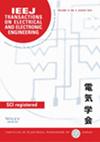Design and Development of a Button-Style Transcutaneous Vagus Nerve Stimulation Device with Integrated PPG for HRV Monitoring†
IF 1.1
4区 工程技术
Q4 ENGINEERING, ELECTRICAL & ELECTRONIC
Thien-Luan Phan, Peng-Ta Liu, Nguyen Van Hieu, Ha Anh T. Nguyen, Ngoc Luan Tran, Duc Huy Nguyen, Ting-Yi Shen, Quy Ha Luu, Daniel H. K. Chow, Henry J. H. Chen, Chih-Lung Lin, Pei-Yi Chu, Pai-Yi Chiu, Cheng-Chung Chang, Congo Tak Shing Ching, Trung Nghia Tran
求助PDF
{"title":"Design and Development of a Button-Style Transcutaneous Vagus Nerve Stimulation Device with Integrated PPG for HRV Monitoring†","authors":"Thien-Luan Phan, Peng-Ta Liu, Nguyen Van Hieu, Ha Anh T. Nguyen, Ngoc Luan Tran, Duc Huy Nguyen, Ting-Yi Shen, Quy Ha Luu, Daniel H. K. Chow, Henry J. H. Chen, Chih-Lung Lin, Pei-Yi Chu, Pai-Yi Chiu, Cheng-Chung Chang, Congo Tak Shing Ching, Trung Nghia Tran","doi":"10.1002/tee.70119","DOIUrl":null,"url":null,"abstract":"<p>Transcutaneous vagus nerve stimulation (tVNS) through auricular points emerges as a potential solution for mitigating depressive symptoms. This paper presents the development and evaluation of a button-style transcutaneous auricular vagus nerve stimulation (taVNS) device for portable treatment and research applications. The device integrates photoplethysmography (PPG) for heart rate variability (HRV) monitoring, enabling real-time evaluation of autonomic nervous system functionality. The system incorporates a user-friendly design, including an Android application for monitoring HRV metrics and adjusting stimulation parameters, ensuring accessibility and personalization. In an initial evaluation involving nine volunteers, five participants demonstrated significant improvements in autonomic nervous system functionality, as evidenced by enhanced SDNN values, while four participants showed minimal response. These results confirmed the usability of the closed-loop device and could potentially enhance future research efforts in personalized taVNS therapy. © 2025 Institute of Electrical Engineers of Japan and Wiley Periodicals LLC.</p>","PeriodicalId":13435,"journal":{"name":"IEEJ Transactions on Electrical and Electronic Engineering","volume":"20 11","pages":"1907-1913"},"PeriodicalIF":1.1000,"publicationDate":"2025-08-02","publicationTypes":"Journal Article","fieldsOfStudy":null,"isOpenAccess":false,"openAccessPdf":"","citationCount":"0","resultStr":null,"platform":"Semanticscholar","paperid":null,"PeriodicalName":"IEEJ Transactions on Electrical and Electronic Engineering","FirstCategoryId":"5","ListUrlMain":"https://onlinelibrary.wiley.com/doi/10.1002/tee.70119","RegionNum":4,"RegionCategory":"工程技术","ArticlePicture":[],"TitleCN":null,"AbstractTextCN":null,"PMCID":null,"EPubDate":"","PubModel":"","JCR":"Q4","JCRName":"ENGINEERING, ELECTRICAL & ELECTRONIC","Score":null,"Total":0}
引用次数: 0
引用
批量引用
Abstract
Transcutaneous vagus nerve stimulation (tVNS) through auricular points emerges as a potential solution for mitigating depressive symptoms. This paper presents the development and evaluation of a button-style transcutaneous auricular vagus nerve stimulation (taVNS) device for portable treatment and research applications. The device integrates photoplethysmography (PPG) for heart rate variability (HRV) monitoring, enabling real-time evaluation of autonomic nervous system functionality. The system incorporates a user-friendly design, including an Android application for monitoring HRV metrics and adjusting stimulation parameters, ensuring accessibility and personalization. In an initial evaluation involving nine volunteers, five participants demonstrated significant improvements in autonomic nervous system functionality, as evidenced by enhanced SDNN values, while four participants showed minimal response. These results confirmed the usability of the closed-loop device and could potentially enhance future research efforts in personalized taVNS therapy. © 2025 Institute of Electrical Engineers of Japan and Wiley Periodicals LLC.
用于HRV监测的带有集成PPG的按钮式经皮迷走神经刺激装置的设计与开发
通过耳穴经皮迷走神经刺激(tVNS)是缓解抑郁症状的潜在解决方案。本文介绍了一种钮扣式经皮耳迷走神经刺激装置(taVNS)的研制和评价,用于便携式治疗和研究应用。该设备集成了用于心率变异性(HRV)监测的光电容积脉搏图(PPG),能够实时评估自主神经系统功能。该系统采用了用户友好的设计,包括一个用于监测HRV指标和调整增产参数的Android应用程序,确保可访问性和个性化。在涉及9名志愿者的初步评估中,5名参与者表现出自主神经系统功能的显着改善,正如SDNN值增强所证明的那样,而4名参与者表现出最小的反应。这些结果证实了闭环装置的可用性,并可能潜在地加强个性化taVNS治疗的未来研究工作。©2025日本电气工程师协会和Wiley期刊有限责任公司。
本文章由计算机程序翻译,如有差异,请以英文原文为准。


 求助内容:
求助内容: 应助结果提醒方式:
应助结果提醒方式:


